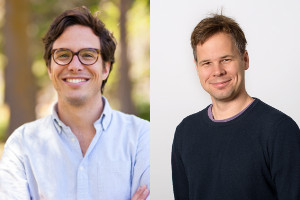September 4, 2017
Two ERC Starting Grants for IST Austria Professors
Johannes Fink and Maximilian Jösch receive prestigious ERC Grants – Projects on quantum networks and neuronal mechanisms of attention funded
Johannes Fink and Maximilian Jösch, both Assistant Professors at the Institute of Science and Technology Austria (IST Austria), have been awarded Starting Grants by the European Research Council (ERC). With the two new awardees, 31 professors at IST Austria have so far been awarded highly prestigious research grants by the ERC. In their funded projects, Johannes Fink, an experimental physicist, will develop a transceiver for fiber optic quantum networks, while Maximilian Jösch, a neuroscientist, will investigate the neuronal mechanisms required for attention.
Maximilian Jösch – Neuronal basis of attention
We are constantly inundated with information. To cope with all the new sights, smells, and sounds that reach us, we and other animals have evolved attention: the ability to selectively concentrate on one thing, like reading this text, while ignoring others, such as the beep alerting us to the newest text message. Disorders that affect the ability to pay attention are a serious public health concern. Attentional disorder, like ADHD and ASD, affect around 5% of children worldwide. However, the attentional mechanisms the nervous system uses are not well understood.
In this project, Maximilian Jösch and his team seek to build a framework to study attention in health and disease by investigating the mouse superior colliculus. This brain region is evolutionarily conserved across vertebrates and known to be involved in attention and in transforming sensory stimuli into goal directed movements, the so-called sensorimotor transformations. By using the mouse modern genetic toolbox to study the brain, the team will monitor the activity of thousands of neurons while observing the animal’s behaviour. This will allow them to understand the neuronal mechanisms involved in sensorimotor transformations. The focus will be on visual information and how visual scenes seen by the mouse are represented and modulated by the superior colliculus. For example, when running through the forest, our brain needs to constantly process information to calculate the distance to the next branch or root to avoid tripping over them. Once the correct calculation is performed, the brain has to inform the motor system to activate the corresponding muscles correctly. The ability to attend to the relevant object in a natural world filled with task-irrelevant information is a non-trivial task. These studies will allow Maximilian Jösch to characterize the neuronal mechanisms of such attentional and goal directed behaviours, as well as to understand the brain-wide modulations that change these computations according to the momentary need of the animal.
In 2009, Maximilian Jösch received his PhD from the Max Planck Institute of Neurobiology and the Ludwig-Maximilians-University Munich, Germany. He then worked as postdoctoral fellow at the Max Planck Institute of Neurobiology, Martinsried, and since 2010, as postdoctoral fellow at Harvard University in the lab of Markus Meister. Maximilian Jösch joined IST Austria as Assistant Professor at the beginning of 2017.
Johannes Fink – Bridging quantum networks and quantum computation
Superconducting quantum processors are expected to soon help solve complex questions faster. The logical next step in quantum computing will be to connect these processors in a quantum web, similar to the way PCs are connected through the internet. One, so far hypothetical, option would be to use the existing fiber optic infrastructure for a quantum network. But research into developing on-chip quantum devices and large-scale networks has progressed largely independently. Advances in the two are often not compatible. In the project funded by the ERC, Johannes Fink will develop a fiber optic transceiver that allows superconducting quantum processors to connect.
Superconducting qubits, single microwave photons, are the “bits” of superconducting quantum processors. They allow for fast processing, but are susceptible to interference, thermal noise, and losses. This limits the use of qubits for quantum communication. In fact, superconducting quantum processors that work with qubits must be cooled to almost absolute zero degrees Kelvin to function. Sending qubits between such processors with a link at room temperature has so far not been possible.
In the ERC-funded project, Fink will bridge the worlds of quantum networks and quantum computation. He seeks to build a transducer using silicon photonics for low-loss fiber optic communication, and integrate this with superconducting circuits for quantum processing. By integrating silicon photonics and superconducting circuits, Fink seeks to achieve a low-loss and high-bandwidth transceiver and extend the range of current fiber optic quantum networks.
Johannes Fink received his PhD in Physics from ETH Zurich, Switzerland, in 2010. After a year as postdoctoral researcher at ETH Zurich, Fink moved to the California Institute of Technology, US. At Caltech, Fink worked as IQIM postdoctoral research scholar from 2012-2015 and as Senior Staff Scientist from 2015-2016. Fink joined IST Austria as Assistant Professor in 2016.




